Accurate Identification of Native Asian Honey Bee Populations in Jilong (Xizang, China) by Population Genomics and Deep Learning
Simple Summary
Abstract
1. Introduction
2. Materials and Methods
2.1. Samples Collection
2.2. DNA Extraction
2.3. Genome Sequencing
2.4. Public Data
2.5. Quality Control
2.6. Mapping and Variant Calling
2.7. Kinship Analysis and Sample Filtering
2.8. Population Structure and Phylogeny
2.9. Lineage Classification
2.10. Functional Enrichment Analysis
3. Results
3.1. Sampling and Genome Sequencing
3.2. Population Structure Analysis Indicates Jilong A. cerana Form a Genetically Distinct Lineage
3.3. FST-Filtered SNPs Enable Accurate Identification and Reveal Functional Divergence in Jilong Honey Bees
3.4. Altitudinal and Spatial Distribution Patterns of Ancestral Components Suggest Concurrent Natural Dispersal and Human-Mediated Introduction of Central Populations in Jilong
4. Discussion
5. Conclusions
Supplementary Materials
Author Contributions
Funding
Data Availability Statement
Acknowledgments
Conflicts of Interest
References
- Sang, H.; Li, Y.; Sun, C. Conservation Genomic Analysis of the Asian Honeybee in China Reveals Climate Factors Underlying Its Population Decline. Insects 2022, 13, 953. [Google Scholar] [CrossRef]
- Yang, G.H. Harm of Introducing the Western Honeybee Apis mellifera L. to the Chinese Honeybee Apis cerana F. and Its Ecological Impact. Acta Entomol. Sin. 2005, 48, 401–406. [Google Scholar]
- Li, J.; Qin, H.; Wu, J.; Sadd, B.M.; Wang, X.; Evans, J.D.; Peng, W.; Chen, Y. The Prevalence of Parasites and Pathogens in Asian Honeybees Apis cerana in China. PLoS ONE 2012, 7, e47955. [Google Scholar] [CrossRef] [PubMed]
- Theisen-Jones, H.; Bienefeld, K. The Asian Honey Bee (Apis cerana) Is Significantly in Decline. Bee World 2016, 93, 90–97. [Google Scholar] [CrossRef]
- Yuan, C.; Jiang, X.; Liu, M.; Yang, S.; Deng, S.; Hou, C. An Investigation of Honey Bee Viruses Prevalence in Managed Honey Bees (Apis mellifera and Apis cerana) Undergone Colony Decline. Open Microbiol. J. 2021, 15, 58–66. [Google Scholar] [CrossRef]
- Chen, B.; Luo, J.-Y. Research Progress of the Population Genetic Differentiation and Environmental Adaptation Mechanisms in Apis cerana cerana (Hymenoptera: Apidae). Acta Entomol. Sin. 2023, 66, 1258–1270. [Google Scholar]
- Zhou, B.F.; Zhou, S.J.; Zhu, X.J.; Xu, X.J. Present Situation of Genetic Resources of Apis cerana cerana in China. Apic. China 2018, 69, 17–21. [Google Scholar]
- Chen, C.; Wang, H.; Liu, Z.; Chen, X.; Tang, J.; Meng, F.; Shi, W. Population Genomics Provide Insights into the Evolution and Adaptation of the Eastern Honey Bee (Apis cerana). Mol. Biol. Evol. 2018, 35, 2260–2271. [Google Scholar] [CrossRef]
- Xu, X.; Zhu, X.; Zhou, S.; Wu, X.; Zhou, B. Genetic Differentiation between Apis cerana cerana Populations from Damen Island and Adjacent Mainland in China. Acta Ecol. Sin. 2013, 33, 122–126. [Google Scholar] [CrossRef]
- Zhao, W.; Wang, M.; Liu, Y.; Gong, X.; Dong, K.; Zhou, D.; He, S. Phylogeography of Apis cerana a Populations on Hainan Island and Southern Mainland China Revealed by Microsatellite Polymorphism and Mitochondrial DNA. Apidologie 2017, 48, 63–74. [Google Scholar] [CrossRef]
- Gao, J.; Tang, X.; Zhao, S.; Tao, K.; Shi, X.; Song, H.; Yao, Y.; Jiang, Y.; Wang, T.; Li, X.; et al. Genomic Analyses of Asian Honeybee from the Sansha Island in the South China Sea, Suggest It’s Evolutional Origin and Environmental Adaption. Front. Bee Sci. 2023, 1, 1144894. [Google Scholar] [CrossRef]
- Sihanuntavong, D.; Sittipraneed, S.; Klinbunga, S. Mitochondrial DNA Diversity and Population Structure of the Honey Bee, Apis cerana, in Thailand. J. Apic. Res. 1999, 38, 211–219. [Google Scholar] [CrossRef]
- Warrit, N.; Smith, D.R.; Lekprayoon, C. Genetic Subpopulations of Varroa Mites and Their Apis cerana Hosts in Thailand. Apidologie 2006, 37, 19–30. [Google Scholar] [CrossRef]
- Xu, X.J.; Zhou, S.J.; Zhu, X.J.; Zhou, B.F. Microsatellite DNA Genetic Diversity of Apis cerana cerana from the Loess Plateau, Northweest China. J. Fujian Agric. For. Univ. 2013, 42, 638–642. [Google Scholar]
- Miguel, I.; Iriondo, M.; Garnery, L.; Sheppard, W.S.; Estonba, A. Gene Flow within the M Evolutionary Lineage of Apis mellifera: Role of the Pyrenees, Isolation by Distance and Post-Glacial Re-Colonization Routes in the Western Europe. Apidologie 2007, 38, 141–155. [Google Scholar] [CrossRef]
- Yu, Y.; Zhou, S.; Zhu, X.; Xu, X.; Wang, W.; Zha, L.; Wang, P.; Wang, J.; Lai, K.; Wang, S.; et al. Genetic Differentiation of Eastern Honey Bee (Apis cerana) Populations across Qinghai-Tibet Plateau-Valley Landforms. Front. Genet. 2019, 10, 483. [Google Scholar] [CrossRef]
- Hu, Y.; Jin, K.; Huang, Z.; Ding, Z.; Liang, J.; Pan, X.; Hu, H.; Jiang, Z. Elevational Patterns of Non-volant Small Mammal Species Richness in Gyirong Valley, Central Himalaya: Evaluating Multiple Spatial and Environmental Drivers. J. Biogeogr. 2017, 44, 2764–2777. [Google Scholar] [CrossRef]
- Hu, Y.M.; Yao, Z.J.; Huang, Z.W.; Tian, Y.; Li, H.B.; Pu, Q.; Yang, D.D.; Hu, H.J. Mammalian Fauna and Its Vertical Changes in Mt. Qomolangma National Nature Reserve, Tibet, China. Acta Theriol. Sin. 2014, 34, 28. [Google Scholar]
- Ji, Y.; Li, X.; Ji, T.; Tang, J.; Qiu, L.; Hu, J.; Dong, J.; Luo, S.; Liu, S.; Frandsen, P.B.; et al. Gene Reuse Facilitates Rapid Radiation and Independent Adaptation to Diverse Habitats in the Asian Honeybee. Sci. Adv. 2020, 6, eabd3590. [Google Scholar] [CrossRef]
- Qiu, L.; Dong, J.; Li, X.; Parey, S.H.; Tan, K.; Orr, M.; Majeed, A.; Zhang, X.; Luo, S.; Zhou, X.; et al. Defining Honeybee Subspecies in an Evolutionary Context Warrants Strategized Conservation. Zool. Res. 2023, 44, 483. [Google Scholar] [CrossRef]
- Yang, B.; Zhou, X.; Liu, S. Tracing the Genealogy Origin of Geographic Populations Based on Genomic Variation and Deep Learning. Mol. Phylogenetics Evol. 2024, 198, 108142. [Google Scholar] [CrossRef]
- Chen, S.; Zhou, Y.; Chen, Y.; Gu, J. Fastp: An Ultra-Fast All-in-One FASTQ Preprocessor. Bioinformatics 2018, 34, i884–i890. [Google Scholar] [CrossRef] [PubMed]
- Li, H. Minimap2: Pairwise Alignment for Nucleotide Sequences. Bioinformatics 2018, 34, 3094–3100. [Google Scholar] [CrossRef] [PubMed]
- Danecek, P.; Bonfield, J.K.; Liddle, J.; Marshall, J.; Ohan, V.; Pollard, M.O.; Whitwham, A.; Keane, T.; McCarthy, S.A.; Davies, R.M.; et al. Twelve Years of SAMtools and BCFtools. Gigascience 2021, 10, giab008. [Google Scholar] [CrossRef] [PubMed]
- Li, H.; Handsaker, B.; Wysoker, A.; Fennell, T.; Ruan, J.; Homer, N.; Marth, G.; Abecasis, G.; Durbin, R.; 1000 Genome Project Data Processing Subgroup. The Sequence Alignment/Map Format and SAMtools. Bioinformatics 2009, 25, 2078–2079. [Google Scholar] [CrossRef]
- Purcell, S.; Neale, B.; Todd-Brown, K.; Thomas, L.; Ferreira, M.A.; Bender, D.; Maller, J.; Sklar, P.; De Bakker, P.I.; Daly, M.J.; et al. PLINK: A Tool Set for Whole-Genome Association and Population-Based Linkage Analyses. Am. J. Hum. Genet. 2007, 81, 559–575. [Google Scholar] [CrossRef]
- Danecek, P.; Auton, A.; Abecasis, G.; Albers, C.A.; Banks, E.; DePristo, M.A.; Handsaker, R.E.; Lunter, G.; Marth, G.T.; Sherry, S.T.; et al. The Variant Call Format and VCFtools. Bioinformatics 2011, 27, 2156–2158. [Google Scholar] [CrossRef]
- Lefort, V.; Desper, R.; Gascuel, O. FastME 2.0: A Comprehensive, Accurate, and Fast Distance-Based Phylogeny Inference Program. Mol. Biol. Evol. 2015, 32, 2798–2800. [Google Scholar] [CrossRef]
- Alexander, D.H.; Novembre, J.; Lange, K. Fast Model-Based Estimation of Ancestry in Unrelated Individuals. Genome Res. 2009, 19, 1655–1664. [Google Scholar] [CrossRef]
- Pedersen, B.S.; Quinlan, A.R. Cyvcf2: Fast, Flexible Variant Analysis with Python. Bioinformatics 2017, 33, 1867–1869. [Google Scholar] [CrossRef]
- Pedregosa, F.; Varoquaux, G.; Gramfort, A.; Michel, V.; Thirion, B.; Grisel, O.; Blondel, M.; Prettenhofer, P.; Weiss, R.; Dubourg, V.; et al. Scikit-Learn: Machine Learning in Python. J. Mach. Learn. Res. 2011, 12, 2825–2830. [Google Scholar]
- McInnes, L.; Healy, J.; Melville, J. Umap: Uniform Manifold Approximation and Projection for Dimension Reduction. arXiv 2018, arXiv:1802.03426. [Google Scholar]
- Waskom, M.L. Seaborn: Statistical Data Visualization. J. Open Source Softw. 2021, 6, 3021. [Google Scholar] [CrossRef]
- Momeni, J.; Parejo, M.; Nielsen, R.O.; Langa, J.; Montes, I.; Papoutsis, L.; Farajzadeh, L.; Bendixen, C.; Căuia, E.; Charrière, J.-D.; et al. Authoritative Subspecies Diagnosis Tool for European Honey Bees Based on Ancestry Informative SNPs. BMC Genom. 2021, 22, 101. [Google Scholar] [CrossRef]
- Cingolani, P.; Platts, A.; Wang, L.L.; Coon, M.; Nguyen, T.; Wang, L.; Land, S.J.; Lu, X.; Ruden, D.M. A Program for Annotating and Predicting the Effects of Single Nucleotide Polymorphisms, SnpEff: SNPs in the Genome of Drosophila Melanogaster Strain W1118; Iso-2; Iso-3. Fly 2012, 6, 80–92. [Google Scholar] [CrossRef] [PubMed]
- Huang, D.W.; Sherman, B.T.; Lempicki, R.A. Systematic and Integrative Analysis of Large Gene Lists Using DAVID Bioinformatics Resources. Nat. Protoc. 2009, 4, 44–57. [Google Scholar] [CrossRef] [PubMed]
- Ilyasov, R.A.; Lee, M.; Takahashi, J.; Kwon, H.W.; Nikolenko, A.G. A Revision of Subspecies Structure of Western Honey Bee Apis mellifera. Saudi J. Biol. Sci. 2020, 27, 3615–3621. [Google Scholar] [CrossRef] [PubMed]
- Lawson, D.J.; Van Dorp, L.; Falush, D. A Tutorial on How Not to Over-Interpret STRUCTURE and ADMIXTURE Bar Plots. Nat. Commun. 2018, 9, 3258. [Google Scholar] [CrossRef]
- Patterson, N.; Price, A.L.; Reich, D. Population Structure and Eigenanalysis. PLoS Genet. 2006, 2, e190. [Google Scholar] [CrossRef]
- Alanis-Lobato, G.; Cannistraci, C.V.; Eriksson, A.; Manica, A.; Ravasi, T. Highlighting Nonlinear Patterns in Population Genetics Datasets. Sci. Rep. 2015, 5, 8140. [Google Scholar] [CrossRef]
- Gözde Çilingir, F.; Uzel, K.; Grossen, C. Genotype Likelihoods Incorporated in Non-Linear Dimensionality Reduction Techniques Infer Fine-Scale Population Genetic Structure. bioRxiv 2024. [Google Scholar] [CrossRef]
- Platzer, A. Visualization of SNPs with T-SNE. PLoS ONE 2013, 8, e56883. [Google Scholar] [CrossRef] [PubMed]
- Gaspar, H.A.; Breen, G. Probabilistic Ancestry Maps: A Method to Assess and Visualize Population Substructures in Genetics. BMC Bioinform. 2019, 20, 116. [Google Scholar] [CrossRef] [PubMed]
- Battey, C.J.; Coffing, G.C.; Kern, A.D. Visualizing Population Structure with Variational Autoencoders. G3 2021, 11, jkaa036. [Google Scholar] [CrossRef] [PubMed]
- Ausmees, K.; Nettelblad, C. A Deep Learning Framework for Characterization of Genotype Data. G3 2022, 12, jkac020. [Google Scholar] [CrossRef]
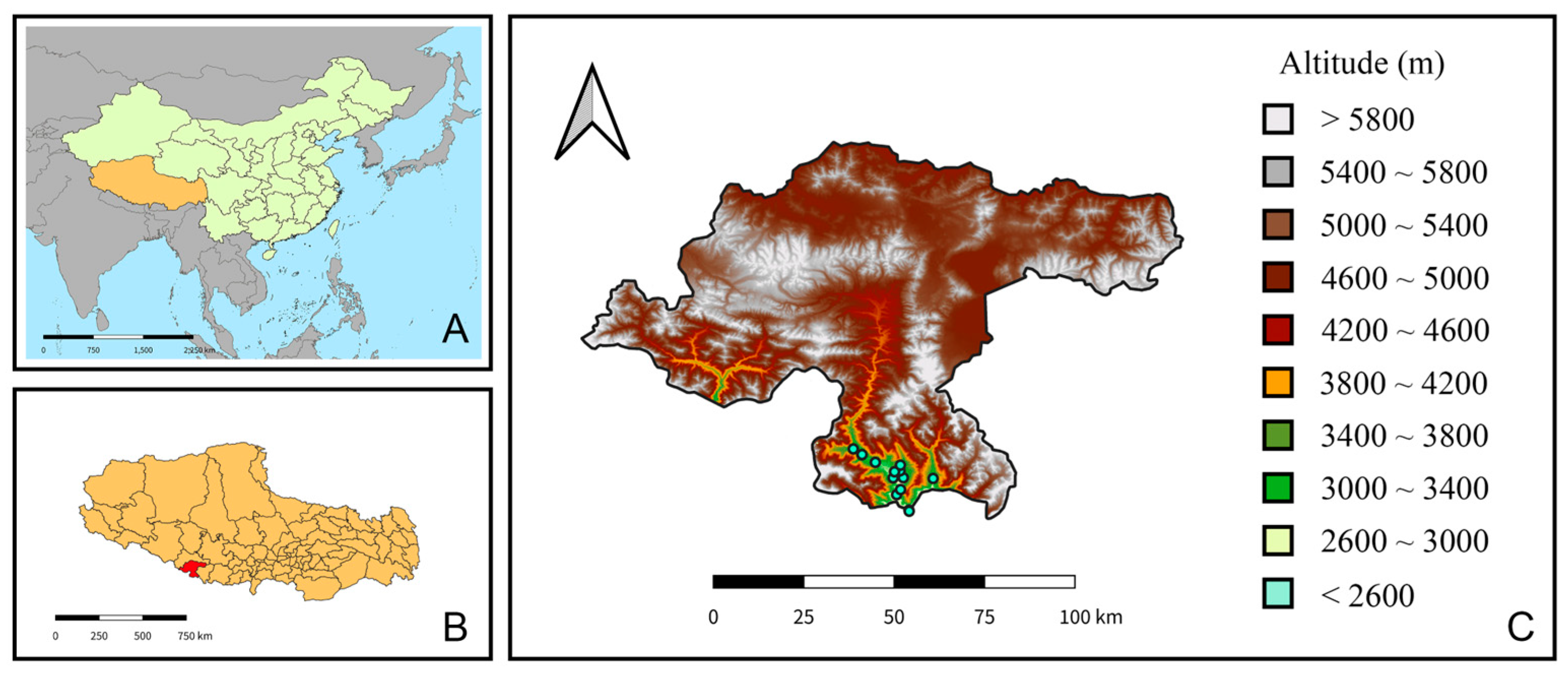
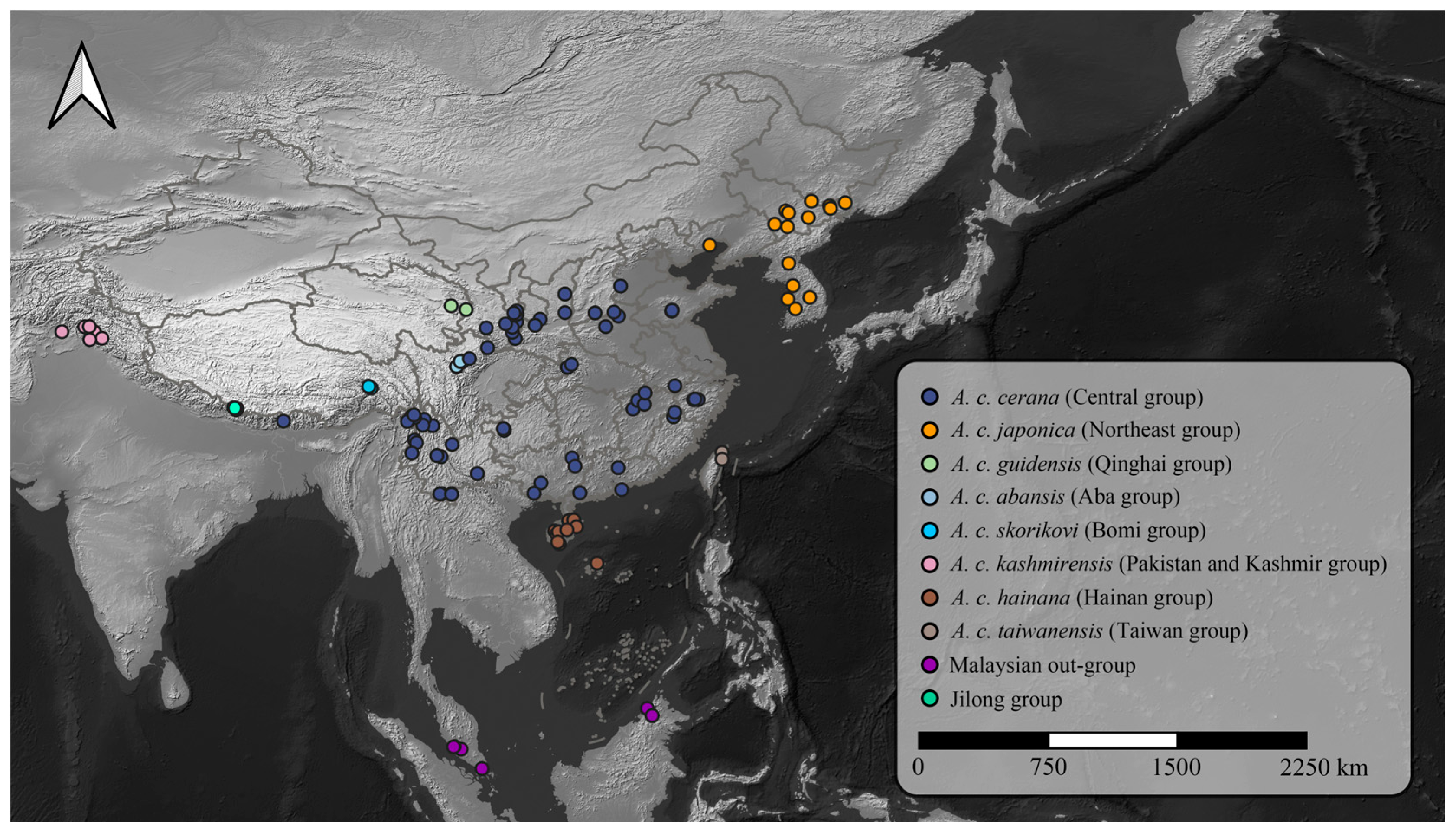
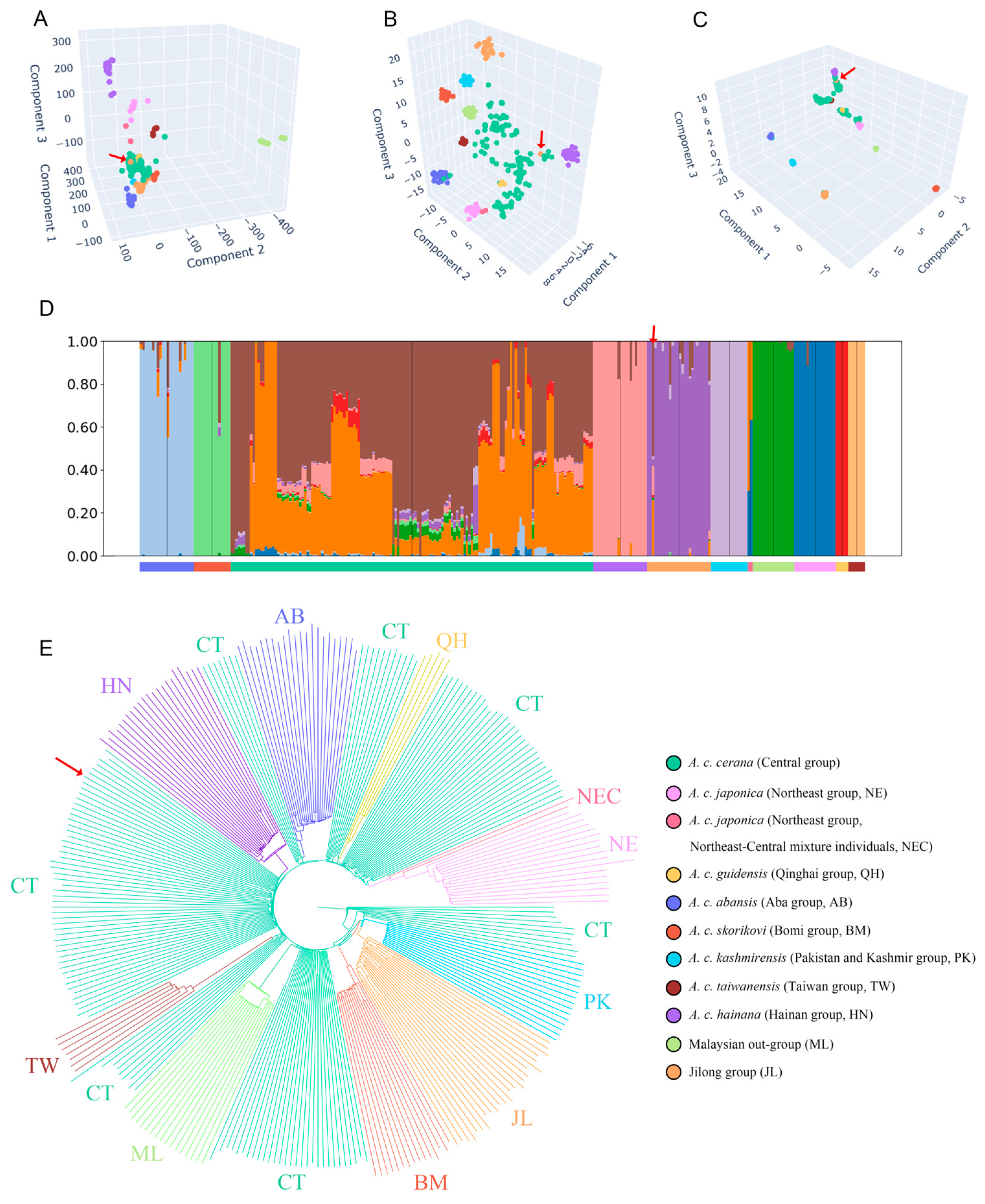
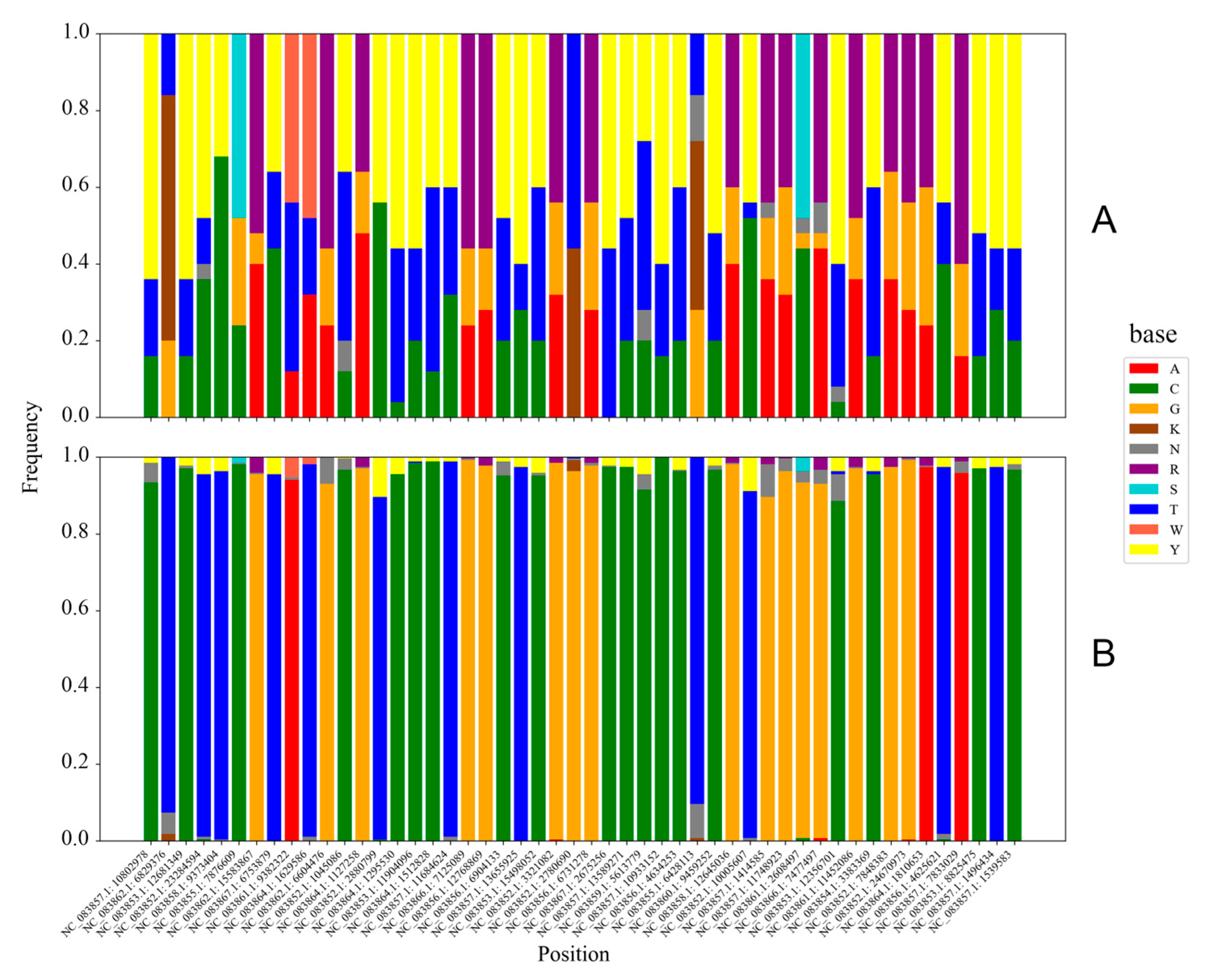
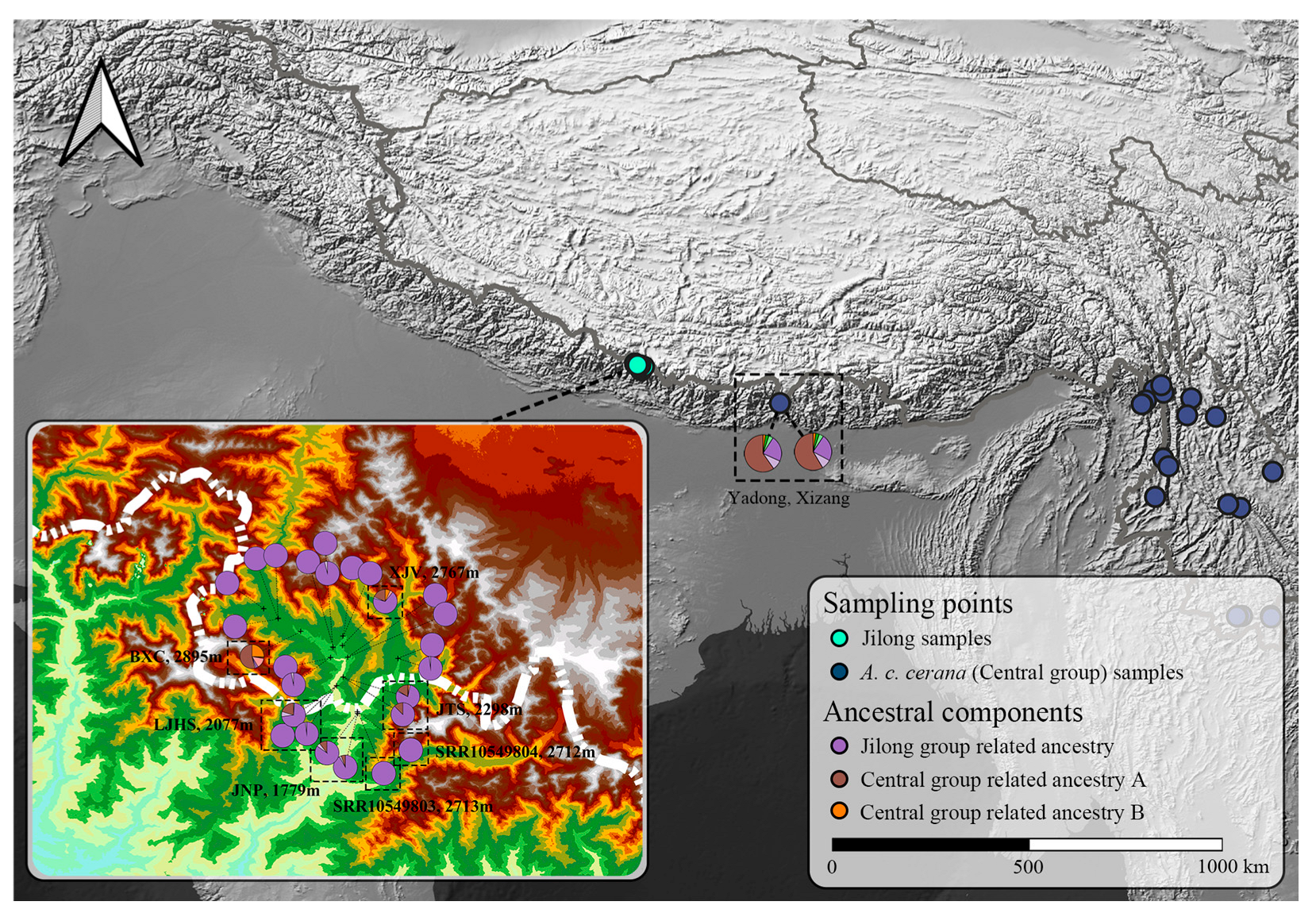
| Sampling Sites | Latitude | Longitude | Altitude (m) | Number of Individuals |
|---|---|---|---|---|
| Jilong–Nepal Port | 28.2767 | 85.3803 | 1779 | 31 |
| Laojiang Village Hot Spring | 28.3235 | 85.3448 | 2077 | 22 |
| Jilong to Port Shelter No. 1 | 28.3380 | 85.3560 | 2298 | 8 |
| Chongse Village | 28.3713 | 85.3637 | 2611 | 13 |
| Jifu Village | 28.3710 | 85.3349 | 2672 | 2 |
| Xinjiang Village | 28.3911 | 85.3546 | 2767 | 1 |
| Rapeseed Fields Around Jilong Town | 28.3884 | 85.3387 | 2854 | 5 |
| Sa’le Town | 28.3693 | 85.4481 | 2928 | 26 |
| Maga Village | 28.4370 | 85.2468 | 3068 | 10 |
| Rema Village | 28.4530 | 85.2220 | 3149 | 4 |
| Naixia Village | 28.4071 | 85.3554 | 3300 | 15 |
| Bangxing Community | 28.4149 | 85.2844 | 2895 | 4 |
Disclaimer/Publisher’s Note: The statements, opinions and data contained in all publications are solely those of the individual author(s) and contributor(s) and not of MDPI and/or the editor(s). MDPI and/or the editor(s) disclaim responsibility for any injury to people or property resulting from any ideas, methods, instructions or products referred to in the content. |
© 2025 by the authors. Licensee MDPI, Basel, Switzerland. This article is an open access article distributed under the terms and conditions of the Creative Commons Attribution (CC BY) license (https://creativecommons.org/licenses/by/4.0/).
Share and Cite
Liu, Z.; Xu, Y.; Sun, W.; Yang, B.; Nyima, T.; Pubu, Z.; Zhou, X.; Da, W.; Luo, S. Accurate Identification of Native Asian Honey Bee Populations in Jilong (Xizang, China) by Population Genomics and Deep Learning. Insects 2025, 16, 788. https://doi.org/10.3390/insects16080788
Liu Z, Xu Y, Sun W, Yang B, Nyima T, Pubu Z, Zhou X, Da W, Luo S. Accurate Identification of Native Asian Honey Bee Populations in Jilong (Xizang, China) by Population Genomics and Deep Learning. Insects. 2025; 16(8):788. https://doi.org/10.3390/insects16080788
Chicago/Turabian StyleLiu, Zhiyu, Yongqiang Xu, Wei Sun, Bing Yang, Tenzin Nyima, Zhuoma Pubu, Xin Zhou, Wa Da, and Shiqi Luo. 2025. "Accurate Identification of Native Asian Honey Bee Populations in Jilong (Xizang, China) by Population Genomics and Deep Learning" Insects 16, no. 8: 788. https://doi.org/10.3390/insects16080788
APA StyleLiu, Z., Xu, Y., Sun, W., Yang, B., Nyima, T., Pubu, Z., Zhou, X., Da, W., & Luo, S. (2025). Accurate Identification of Native Asian Honey Bee Populations in Jilong (Xizang, China) by Population Genomics and Deep Learning. Insects, 16(8), 788. https://doi.org/10.3390/insects16080788






